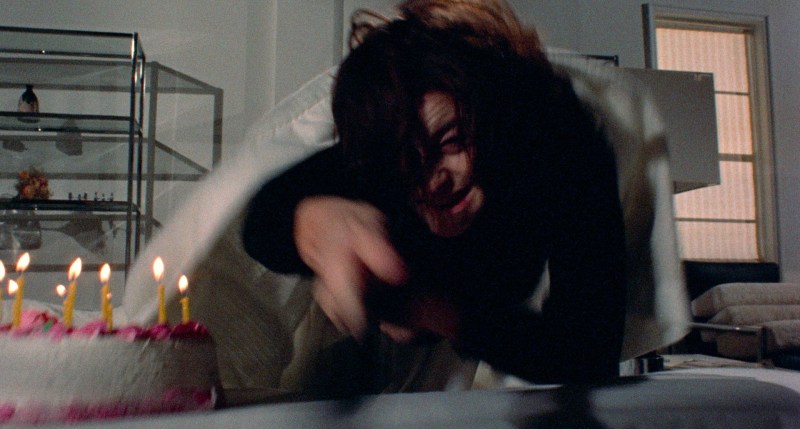The literary luminary TS Eliot used a simple maxim to differentiate between writers. He claimed that, “Immature poets imitate; mature poets steal.” By Eliot’s criterion, Brian de Palma was already a mature artist at age 33, at which time he made “Sisters” (1973). Still, a synopsis of the film can make it seem sophomoric; Danielle Breton was born a conjoined twin, but after a successful separation surgery, she moves to Staten Island and appears on a game show. One of the contestants falls madly in love with her. Still, any romance that blossoms on the program “Peeping Toms” is destined to end perversely. In the morning, Danielle’s lover goes out to buy her a birthday cake, and when he returns to her apartment, a mysterious figure stabs him to death. Danielle awakens and recoils in terror. She is not the only individual shaken by the murder. Grace, an intrepid reporter, happened to be peering into Danielle’s window when the crime occurred. She calls the police and resolves to find the killer. What mature artist meditates on conjoined twins and “Peeping Toms”?
Yet, despite the story’s contrivances, de Palma’s ingenious execution distinguishes the film from other thrillers. While immature directors would be content to repeat tired tropes, de Palma commandeers the techniques of directors like Alfred Hitchcock and Andy Warhol to create an idiosyncratic thriller.
De Palma first became fascinated with film when he saw Hitchcock’s “Vertigo” in 1958. As he told the journalist Robert Siegel years later, “There was something about the way the story was told and the cinematic language used in it that connected to me.” There are numerous references to Hitchcock’s captivating cinematic language in “Sisters.” Just as James Stewart follows an enigmatic woman in “Vertigo,” Grace must uncover all of Danielle’s secrets. In Hitchcock’s “Rear Window,” Stewart witnesses a murder while gazing out of his apartment. Grace watches the murder from a similar vantage point. Late in the film, Danielle has a disturbing dream. It recalls the surreal sequence that Salvador Dali designed for Hitchcock in “Spellbound.” De Palma reinforces the connection by rendering the scene in Hitchcock’s stark black-and-white. The film also alludes to Hitchcock’s work sonically. Bernard Herrmann scored some of Hitchcock’s greatest films, and de Palma lured the veteran composer out of retirement to score “Sisters.” Herrmann’s music matches de Palma’s mise-en-scène. He uses some of the same haunting harmonies featured in “Vertigo” and the screeching violins of “Psycho,” but he recombines these elements into a delightfully disquieting melody.
Likewise, de Palma reinvents the elements he embezzled from Hitchcock. While many of Hitchcock’s films are set in exotic locales or idealized American towns, “Sisters” takes place on the gritty streets of New York in the 1970s. Grace is a reporter, so she is inextricably connected to the social climate of her times. While James Stewart in “Rear Window” simply describes the crime he saw as heinous, Grace believes that bigotry played a role in this murder. Danielle’s lover was African-American, and his assailant was white. Hitchcock’s original conceit is transformed because of the realities of race relations. Many of Hitchcock’s protagonists are wrongly accused of transgressions and are forced to become fugitives; Grace is on the run from the law, too, not because of an infraction, but because she has been critical of the police’s harsh tactics. Even Danielle’s dream reflects her milieu – the camera invades her personal space, and grotesque imagery frightens her less than the cruel curiosity of New Yorkers.
“Sisters” is also a film about New York in that it draws on the underground pictures made in the city. Perhaps the most famous of these movies is Andy Warhol’s “Chelsea Girls,” released in 1966. Warhol made 12 half-hour films documenting various happenings in New York’s Chelsea Hotel, but during editing, he realized that a six-hour film was unlikely to be commercially lucrative. Therefore, he decided to use split-screen and show two films at the same time. Viewers would be overwhelmed with visual information, and they would have to decide which film to watch.
De Palma employs split-screen to an analogous effect in “Sisters.” Shortly after the murder occurs, de Palma divides the frame in two. On one side, Grace calls the police. On the other, Danielle frantically tries to dispose of the body. It is impossible to concentrate on all of their minute actions, so a viewer must decide which side of the story he cares most about. Does he follow Grace’s dogged effort to uncover the truth, or does he sympathize with Danielle’s attempts to maintain her innocence?
The split-screen is not only disorienting, but it also reflects the film’s themes. Danielle was born a conjoined twin, and although she now functions independently of her sister, the split-screen conjoins her to Grace. Just as conjoined twins share a body part, Danielle and Grace are forced to coexist within the same frame. In a strange sense, these two protagonists become sisters. Despite their different aims and attitudes, the flighty French model and the hardboiled journalist have a kind of kinship.
De Palma is similarly conjoined to earlier auteurs. Yet, just as Danielle is able to survive separately from her sister and from Grace, de Palma’s work is able to stand on its own. “Sisters” is far from a facsimile: It’s a fully formed masterpiece from a major filmmaker.
Contact Amir Abou-Jaoude at amir2 ‘at’ stanford.edu.
